Results by Title
6 books about National Association of City Transportation Officials
6 books about National Association of City Transportation Officials
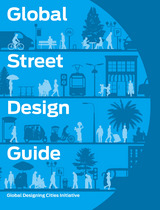
Global Street Design Guide
Global Designing Cities Initiative
Island Press, 2016
Each year, 1.2 million people die from traffic fatalities, highlighting the need to design streets that offer safe and enticing travel choices for all people. Cities around the world are facing the same challenges as cities in the US, and many of these problems are rooted in outdated codes and standards.
The Global Street Design Guide is a timely resource that sets a global baseline for designing streets and public spaces and redefines the role of streets in a rapidly urbanizing world. The guide will broaden how to measure the success of urban streets to include: access, safety, mobility for all users, environmental quality, economic benefit, public health, and overall quality of life. The first-ever worldwide standards for designing city streets and prioritizing safety, pedestrians, transit, and sustainable mobility are presented in the guide. Participating experts from global cities have helped to develop the principles that organize the guide. The Global Street Design Guide builds off the successful tools and tactics defined in NACTO’s Urban Street Design Guide and Urban Bikeway Design Guide while addressing a variety of street typologies and design elements found in various contexts around the world.
This innovative guide will inspire leaders, inform practitioners, and empower communities to realize the potential in their public space networks. It will help cities unlock the potential of streets as safe, accessible, and economically sustainable places.
Example cities include: Bangalore, India; Buenos Aires, Argentina; Paris, France; Copenhagen, Denmark; Seoul, Korea; Medellin, Colombia; Toronto, Canada; Istanbul, Turkey; Auckland, New Zealand; Melbourne, Australia; New York, USA; and San Francisco, USA.
The Global Street Design Guide is a timely resource that sets a global baseline for designing streets and public spaces and redefines the role of streets in a rapidly urbanizing world. The guide will broaden how to measure the success of urban streets to include: access, safety, mobility for all users, environmental quality, economic benefit, public health, and overall quality of life. The first-ever worldwide standards for designing city streets and prioritizing safety, pedestrians, transit, and sustainable mobility are presented in the guide. Participating experts from global cities have helped to develop the principles that organize the guide. The Global Street Design Guide builds off the successful tools and tactics defined in NACTO’s Urban Street Design Guide and Urban Bikeway Design Guide while addressing a variety of street typologies and design elements found in various contexts around the world.
This innovative guide will inspire leaders, inform practitioners, and empower communities to realize the potential in their public space networks. It will help cities unlock the potential of streets as safe, accessible, and economically sustainable places.
Example cities include: Bangalore, India; Buenos Aires, Argentina; Paris, France; Copenhagen, Denmark; Seoul, Korea; Medellin, Colombia; Toronto, Canada; Istanbul, Turkey; Auckland, New Zealand; Melbourne, Australia; New York, USA; and San Francisco, USA.
[more]
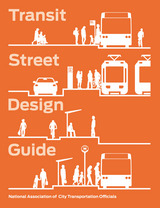
Transit Street Design Guide
National Association of City Transportation Officials
Island Press, 2016
Transit and cities grow together. As cities work to become more compact, sustainable, and healthy, their work is paying dividends: in 2014, Americans took 10.8 billion trips on public transit, the highest since the dawn of the highway era. But most of these trips are on streets that were designed to move private cars, with transit as an afterthought. The NACTO Transit Street Design Guide places transit where it belongs, at the heart of street design. The guide shows how streets of every size can be redesigned to create great transit streets, supporting great neighborhoods and downtowns.
The Transit Street Design Guide is a well-illustrated, detailed introduction to designing streets for high-quality transit, from local buses to BRT, from streetcars to light rail. Drawing on the expertise of a peer network and case studies from across North America, the guide provides a much-needed link between transit planning, transportation engineering, and street design. The Transit Street Design Guide presents a new set of core principles, street typologies, and design strategies that shift the paradigm for streets, from merely accommodating service to actively prioritizing great transit. The book expands on the transit information in the acclaimed Urban Street Design Guide, with sections on comprehensive transit street design, lane design and materials, stations and stops, intersection strategies, and city transit networks. It also details performance measures and outlines how to make the case for great transit street design in cities.
The guide is built on simple math: allocating scarce space to transit instead of private automobiles greatly expands the number of people a street can move. Street design and decisions made by cities, from how to time signals to where bus stops are placed, can dramatically change how transit works and how people use it.
The Transit Street Design Guide is a vital resource for every transportation planner, transit operations planner, and city traffic engineer working on making streets that move more people more efficiently and affordably.
The Transit Street Design Guide is a well-illustrated, detailed introduction to designing streets for high-quality transit, from local buses to BRT, from streetcars to light rail. Drawing on the expertise of a peer network and case studies from across North America, the guide provides a much-needed link between transit planning, transportation engineering, and street design. The Transit Street Design Guide presents a new set of core principles, street typologies, and design strategies that shift the paradigm for streets, from merely accommodating service to actively prioritizing great transit. The book expands on the transit information in the acclaimed Urban Street Design Guide, with sections on comprehensive transit street design, lane design and materials, stations and stops, intersection strategies, and city transit networks. It also details performance measures and outlines how to make the case for great transit street design in cities.
The guide is built on simple math: allocating scarce space to transit instead of private automobiles greatly expands the number of people a street can move. Street design and decisions made by cities, from how to time signals to where bus stops are placed, can dramatically change how transit works and how people use it.
The Transit Street Design Guide is a vital resource for every transportation planner, transit operations planner, and city traffic engineer working on making streets that move more people more efficiently and affordably.
[more]
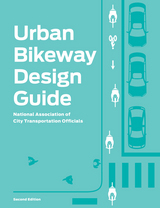
Urban Bikeway Design Guide, Second Edition
National Association of City Transportation Officials
Island Press, 2014
The NACTO Urban Bikeway Design Guide, Second Edition, is based on the experience of the best cycling cities in the world. Completely re-designed with an accessible, four-color layout, this second edition continues to build upon the fast-changing state of the practice at the local level. The designs in this book were developed by cities for cities, since unique urban streets require innovative solutions.
To create the Guide, the authors conducted an extensive worldwide literature search from design guidelines and real-life experience. They worked closely with a panel of urban bikeway planning professionals from NACTO member cities and from numerous other cities worldwide, as well as traffic engineers, planners, and academics with deep experience in urban bikeway applications. The Guide offers substantive guidance for cities seeking to improve bicycle transportation in places where competing demands for the use of the right-of-way present unique challenges.
First and foremost, the NACTO Urban Bikeway Design Guide, Second Edition will help practitioners make good decisions about urban bikeway design. The treatments outlined in this updated Guide are based on real-life experience in the world's most bicycle friendly cities and have been selected because of their utility in helping cities meet their goals related to bicycle transportation. Praised by Former Transportation Secretary Ray LaHood as an “extraordinary piece of work,” the Guide is an indispensable tool every planner must have for their daily transportation design work.
To create the Guide, the authors conducted an extensive worldwide literature search from design guidelines and real-life experience. They worked closely with a panel of urban bikeway planning professionals from NACTO member cities and from numerous other cities worldwide, as well as traffic engineers, planners, and academics with deep experience in urban bikeway applications. The Guide offers substantive guidance for cities seeking to improve bicycle transportation in places where competing demands for the use of the right-of-way present unique challenges.
First and foremost, the NACTO Urban Bikeway Design Guide, Second Edition will help practitioners make good decisions about urban bikeway design. The treatments outlined in this updated Guide are based on real-life experience in the world's most bicycle friendly cities and have been selected because of their utility in helping cities meet their goals related to bicycle transportation. Praised by Former Transportation Secretary Ray LaHood as an “extraordinary piece of work,” the Guide is an indispensable tool every planner must have for their daily transportation design work.
[more]
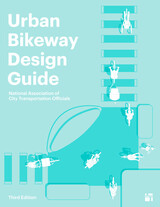
Urban Bikeway Design Guide, Third Edition
National Association of City Transportation Officials, NACTO
Island Press, 2024
Over a decade ago, the first edition of the NACTO Urban Bikeway Design Guide sparked a design revolution in cities. City streets are now understood as key elements in confronting the intertwined safety, equity, and climate crises in North America.
The completely revised and updated third edition of the NACTO Urban Bikeway Design Guide sets a new standard for street design in North America. Developed for cities, by cities, the new guide is more than a permission slip for better street design--it's a prescription for safe, connected, equitable bike networks. It captures lessons learned and emerging practices to set a new bar for the design of city streets.
The NACTO Urban Bikeway Design Guide, Third Edition, will help city leaders and street designers meet the needs of our time. New topics address critical gaps in existing guidance for planning and project development. Contextual guidance for bikeway design encompasses the needs of a wider swath of potential riders, across genders, ages, races, ethnicities, incomes, and abilities. The guide offers substantive guidance for safe intersection design, with a focus on conflict reduction. It is a blueprint for implementing safe, connected, and equitable bike networks. Every transportation professional, from design to maintenance and from field staff to executives, needs a copy for their daily work.
Praise for the second edition
“NACTO's Urban Bikeway Design Guide gives American planners and designers the tools they need to make cycling accessible to more people.”
—Janette Sadik-Khan, former New York City Transportation Commissioner
“This is an extraordinary piece of work that's long overdue.”
—Ray LaHood, former United States Secretary of Transportation
“The guide will serve as an essential blueprint for safe, active, multi-modal streets.”
—Gabe Klein, former Chicago Transportation Commissioner
“A Must-read… Landscape architects, planners, and city officials should find this guide invaluable. Anyone who advocates for increasing bicycle infrastructure in our cities will find many useful tools for implementing best practice infrastructure.”
―ASLA's The Dirt
The completely revised and updated third edition of the NACTO Urban Bikeway Design Guide sets a new standard for street design in North America. Developed for cities, by cities, the new guide is more than a permission slip for better street design--it's a prescription for safe, connected, equitable bike networks. It captures lessons learned and emerging practices to set a new bar for the design of city streets.
The NACTO Urban Bikeway Design Guide, Third Edition, will help city leaders and street designers meet the needs of our time. New topics address critical gaps in existing guidance for planning and project development. Contextual guidance for bikeway design encompasses the needs of a wider swath of potential riders, across genders, ages, races, ethnicities, incomes, and abilities. The guide offers substantive guidance for safe intersection design, with a focus on conflict reduction. It is a blueprint for implementing safe, connected, and equitable bike networks. Every transportation professional, from design to maintenance and from field staff to executives, needs a copy for their daily work.
Praise for the second edition
“NACTO's Urban Bikeway Design Guide gives American planners and designers the tools they need to make cycling accessible to more people.”
—Janette Sadik-Khan, former New York City Transportation Commissioner
“This is an extraordinary piece of work that's long overdue.”
—Ray LaHood, former United States Secretary of Transportation
“The guide will serve as an essential blueprint for safe, active, multi-modal streets.”
—Gabe Klein, former Chicago Transportation Commissioner
“A Must-read… Landscape architects, planners, and city officials should find this guide invaluable. Anyone who advocates for increasing bicycle infrastructure in our cities will find many useful tools for implementing best practice infrastructure.”
―ASLA's The Dirt
[more]
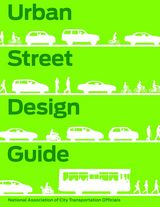
Urban Street Design Guide
National Association of City Transportation Officials
Island Press, 2013
The NACTO Urban Street Design Guide shows how streets of every size can be reimagined and reoriented to prioritize safe driving and transit, biking, walking, and public activity. Unlike older, more conservative engineering manuals, this design guide emphasizes the core principle that urban streets are public places and have a larger role to play in communities than solely being conduits for traffic.
The well-illustrated guide offers blueprints of street design from multiple perspectives, from the bird’s eye view to granular details. Case studies from around the country clearly show how to implement best practices, as well as provide guidance for customizing design applications to a city’s unique needs. Urban Street Design Guide outlines five goals and tenets of world-class street design:
• Streets are public spaces. Streets play a much larger role in the public life of cities and communities than just thoroughfares for traffic.
• Great streets are great for business. Well-designed streets generate higher revenues for businesses and higher values for homeowners.
• Design for safety. Traffic engineers can and should design streets where people walking, parking, shopping, bicycling, working, and driving can cross paths safely.
• Streets can be changed. Transportation engineers can work flexibly within the building envelope of a street. Many city streets were created in a different era and need to be reconfigured to meet new needs.
• Act now! Implement projects quickly using temporary materials to help inform public decision making.
Elaborating on these fundamental principles, the guide offers substantive direction for cities seeking to improve street design to create more inclusive, multi-modal urban environments. It is an exceptional resource for redesigning streets to serve the needs of 21st century cities, whose residents and visitors demand a variety of transportation options, safer streets, and vibrant community life.
The well-illustrated guide offers blueprints of street design from multiple perspectives, from the bird’s eye view to granular details. Case studies from around the country clearly show how to implement best practices, as well as provide guidance for customizing design applications to a city’s unique needs. Urban Street Design Guide outlines five goals and tenets of world-class street design:
• Streets are public spaces. Streets play a much larger role in the public life of cities and communities than just thoroughfares for traffic.
• Great streets are great for business. Well-designed streets generate higher revenues for businesses and higher values for homeowners.
• Design for safety. Traffic engineers can and should design streets where people walking, parking, shopping, bicycling, working, and driving can cross paths safely.
• Streets can be changed. Transportation engineers can work flexibly within the building envelope of a street. Many city streets were created in a different era and need to be reconfigured to meet new needs.
• Act now! Implement projects quickly using temporary materials to help inform public decision making.
Elaborating on these fundamental principles, the guide offers substantive direction for cities seeking to improve street design to create more inclusive, multi-modal urban environments. It is an exceptional resource for redesigning streets to serve the needs of 21st century cities, whose residents and visitors demand a variety of transportation options, safer streets, and vibrant community life.
[more]
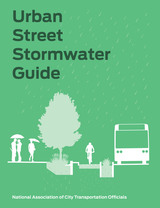
Urban Street Stormwater Guide
National Association of City Transportation Officials
Island Press, 2017
Streets make up more than 80 percent of all public space in cities, yet street space is often underutilized or disproportionately allocated to the movement of private motor vehicles. Excess impervious surface contributes to stormwater runoff, posing a threat to the environment and human health, and often overwhelming sewer systems. This excess asphalt also poses a threat to public safety, encouraging faster speeds and dangerous conditions for people walking and biking.
The Urban Street Stormwater Guide begins from the principle that street design can support—or degrade—the urban area’s overall environmental health. By incorporating Green Stormwater Infrastructure (GSI) into the right-of-way, cities can manage stormwater and reap the public health, environmental, and aesthetic benefits of street trees, planters, and greenery in the public realm. With thoughtful design, GSI can bolster strategies to provide a safe and pleasant walking and biking experience, efficient and reliable transit service, and safer streets for all users.
Building on the successful NACTO urban street guides, the Urban Street Stormwater Guide provides the best practices for the design of GSI along transportation corridors. The authors consider context-sensitive design elements related to street design, character and use, zoning, posted speed, traffic volumes, and impacts to non-motorized and vehicular access. The Guide documents and synthesizes current practices being developed by individual agencies and recommends design guidance for implementation, as well as explores innovative new strategies being tested in cities nationwide. The guidance will focus on providing safe, functioning and maintainable infrastructure that meets the unique needs and requirements of the transportation corridors and its various uses and users.
The state-of-the-art solutions in this guide will assist urban planners and designers, transportation engineers, city officials, ecologists, public works officials, and others interested in the role of the built urban landscape in protecting the climate, water quality, and natural environment.
The Urban Street Stormwater Guide begins from the principle that street design can support—or degrade—the urban area’s overall environmental health. By incorporating Green Stormwater Infrastructure (GSI) into the right-of-way, cities can manage stormwater and reap the public health, environmental, and aesthetic benefits of street trees, planters, and greenery in the public realm. With thoughtful design, GSI can bolster strategies to provide a safe and pleasant walking and biking experience, efficient and reliable transit service, and safer streets for all users.
Building on the successful NACTO urban street guides, the Urban Street Stormwater Guide provides the best practices for the design of GSI along transportation corridors. The authors consider context-sensitive design elements related to street design, character and use, zoning, posted speed, traffic volumes, and impacts to non-motorized and vehicular access. The Guide documents and synthesizes current practices being developed by individual agencies and recommends design guidance for implementation, as well as explores innovative new strategies being tested in cities nationwide. The guidance will focus on providing safe, functioning and maintainable infrastructure that meets the unique needs and requirements of the transportation corridors and its various uses and users.
The state-of-the-art solutions in this guide will assist urban planners and designers, transportation engineers, city officials, ecologists, public works officials, and others interested in the role of the built urban landscape in protecting the climate, water quality, and natural environment.
[more]
READERS
Browse our collection.
PUBLISHERS
See BiblioVault's publisher services.
STUDENT SERVICES
Files for college accessibility offices.
UChicago Accessibility Resources
home | accessibility | search | about | contact us
BiblioVault ® 2001 - 2024
The University of Chicago Press









